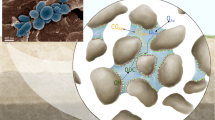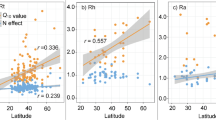Abstract
The temperature sensitivity of soil respiration will largely determine the effects of a warmer world on net carbon flux from soils to the atmosphere. CO2 flux from soils to the atmosphere is estimated to be 50–70 petagrams of carbon per year and makes up 20–38% of annual inputs of carbon (in the form of CO2) to the atmosphere from terrestrial and marine sources1,2. Here we show that, for a mixed temperate forest, respiration by roots plus oxidation of rhizosphere carbon, which together produce a large portion of total effluxed soil CO2, is more temperature-sensitive than the respiration of bulk soil. We determine that the Q10 value (the coefficient for the exponential relationship between soil respiration and temperature, multiplied by ten) is 4.6 for autotrophic root respiration plus rhizosphere decomposition, 2.5 for respiration by soil lacking roots and 3.5 for respiration by bulk soil. If plants in a higher-CO2 atmosphere increase their allocation of photosynthate to roots3,4,5,6 these findings suggest that soil respiration should be more sensitive to elevated temperatures, thus limiting carbon sequestration by soils.
This is a preview of subscription content, access via your institution
Access options
Subscribe to this journal
Receive 51 print issues and online access
$199.00 per year
only $3.90 per issue
Buy this article
- Purchase on Springer Link
- Instant access to full article PDF
Prices may be subject to local taxes which are calculated during checkout




Similar content being viewed by others
References
Raich, J. W. & Schlesinger, W. H. The Global patterns of carbon dioxide flux in soil respiration and its relationship to vegtation and climate. Tellus 44B9, 81–99 (1992).
Raich, J. W. & Potter, C. S. Global patterns of carbon dioxide emissions from soils. Global Biogeochem. Cycles 9, 23–26 (1995).
Fitter, A. H. et al. Root production and mortality under elevated atmospheric carbon dioxide. Plant Soil 187, 299–306 (1996).
Canadell, J. G., Pitelka, L. F. & Ingram, J. S. I. The effects of elevated [CO2] on plant-soil carbon belowground: a summary and synthesis. Plant Soil 187, 391–400 (1997).
Cardon, Z. Influence of rhizodeposition under elevated CO2on plant nutrition and soil organic matter. Plant Soil 187, 277–288 (1997).
Hungate, B. A. et al. The fate of carbon in grasslands under carbon dioxide enrichment. Nature 388, 576–579 (1997).
Holland, E. A., Townsend, A. R. & Vitousek, P. M. Variability in temperature regulation of CO2fluxes and N mineralization from five Hawaiian soils: implications for a changing climate. Global Change Biol. 1, 115–123 (1995).
Townsend, A. R., Vitousek, P. M. & Holland, E. A. Tropical soils dominate the short term carbon cycle feedbacks to atmospheric carbon dioxide. Clim. Change 22, 293–303 (1992).
Fung, I. Y., Tucker, C. J. & Prentice, K. C. Application of advanced very high resolution vegetation index to study atmosphere-biosphere exchange of CO2. J. Geophys. Res. 92, 2999–3015 (1987).
Kicklighter, D. W. et al. Aspects of spatial and temporal aggregation in estimating regional carbon dioxide fluxes from temperate forest soils. J. Geophys. Res. 99, 1303–1315 (1994).
Xiao, X. et al. Transient climate change and net ecosystem production of the terrestrial biosphere. Global Biogeochem. Cycles 12, 345–360 (1998).
Schleser, G. H. The response of CO2evolution from soils to global temperature changes. Z. Naturforsch. 37, 287–291 (1982).
Kirschbaum, M. U. F. The temperature dependence of soil organic matter decomposition, and the effect of global warming on soil organic C storage. Soil Biol. Biochem. 27, 753–760 (1995).
Trumbore, S. E., Chadwick, O. A. & Amundson, R. Rapid exchange between soil carbon and atmospheric carbon dioxide driven by temperature change. Science 272, 393–396 (1996).
Bowden, R. D., Nadelhoffer, K. J., Boone, R. D., Melillo, J. M. & Garrison, J. B. Contributions of aboveground litter, belowground litter, and root respiration to total soil respiration in a temperate mixed hardwood forest. Can. J. For. Res. 23, 1402–1407 (1993).
Davidson, E. A., Belk, E. & Boone, R. D. Soil water content and temperature as independent or confounded factors controlling soil respiration in a temperate mixed hardwood forest. Global Change Biol. 4, 217–228 (1998).
Ross, D. J. & Tate, K. R. Microbial C and N, and respiratory activity, in litter and soil of a southern beech (Nothofagus) forest: distribution and properties. Soil Biol. Biochem. 25, 477–483 (1993).
Winkler, J. P., Cherry, R. S. & Schlesinger, W. H. The Q10relationship of microbial respiration in a temperate forest soil. Soil Biol. Biochem. 28, 1067–1072 (1996).
Lawrence, W. T. & Oechel, W. C. Effects of soil temperature on the carbon exchange of taiga seedlings. I. Root respiration. Can. J. For. Res. 13, 840–849 (1983).
Burton, A. J., Pregitzer, K. S., Zogg, G. P. & Zak, D. R. Latitudinal variation in sugar maple fine root respiration. Can. J. For. Res. 26, 1761–1768 (1996).
Ryan, M. G., Hubbard, R. M., Pongracic, S., Raison, R. J. & McMurtrie, R. E. Foliage, fine-root, woody tissue and stand respiration in Pinus radiata in relation to nitrogen status. Tree Physiol. 9, 255–266 (1996).
Zogg, G. P., Zak, D. R., Burton, A. J. & Pregitzer, K. S. Fine root respiration in northern hardwood forests in relation to temperature and nitrogen availability. Tree Physiol. 16, 719–725 (1996).
Burton, A. J., Pregitzer, K. S., Zogg, G. P. & Zak, D. R. Drought reduces root respiration in sugar maple forests. Ecol. Appl. 8, 771–773 (1998).
Anderson, J. M. Carbon dioxide evolution from two temperature, deciduous woodland soils. J. Appl. Ecol. 10, 361–378 (1973).
Dörr, H. & Münnich, K. O. Annual variation in soil respiration in selected areas of the temperate zone. Tellus 39B, 114–121 (1987).
Johnson, D. et al. Soil pCO2, soil respiration, and root activity in CO2-fumigated and nitrogen-fertilized ponderosa pine. Plant Soil 165, 129–138 (1994).
Thierron, V. & Laudelout, H. Contribution of root respiration to total CO2efflux from the soil of a deciduous forest. Can. J. For. Res. 26, 1142–1148 (1996).
Hanson, P. J., Edwards, N. T., Garten, C. T. J & Andrews, J. A. Separating root and soil microbial contributions to soil respiration: a review of methods and observations. Biogeochemistry (submitted).
Newkirk, K. M., Bowles, F. P. & Catricala, C. E. Time domain reflectometry in forest soils: in-situ use at the Harvard Forest Soil Warming Experiment. Agron. Abstr. 235 (1994).
Topp, G. C., Davis, J. L. & Annan, A. P. Electromagnetic determination of soil water content: measurements in coaxial transmission lines. Wat. Resour. Res. 16, 574–582 (1980).
Acknowledgements
We thank E. Davidson and E. Sundquist for advice on construction of the field system for measuring soil respiration; E. Davidson for help with analysis of soil respiration data: K.Newkirk and F. Bowles for help with the design, fabrication and use of the TDR system; and A. Doyle forcritical review of the manuscript. This work was sponsored by grants from the US NSF Long-Term Ecological Research Program, the Department of Energy NIGEC Program and the US Department of Agriculture Competitive Grants Program.
Author information
Authors and Affiliations
Corresponding author
Rights and permissions
About this article
Cite this article
Boone, R., Nadelhoffer, K., Canary, J. et al. Roots exert a strong influence on the temperature sensitivityof soil respiration. Nature 396, 570–572 (1998). https://doi.org/10.1038/25119
Received:
Accepted:
Issue Date:
DOI: https://doi.org/10.1038/25119
This article is cited by
-
Universal temperature sensitivity of denitrification nitrogen losses in forest soils
Nature Climate Change (2023)
-
Divergent data-driven estimates of global soil respiration
Communications Earth & Environment (2023)
-
Response of soil respiration to short-term changes in precipitation and nitrogen addition in a desert steppe
Journal of Arid Land (2023)
-
Seasonal climate impact on Brazilian pasture (Brachiaria brizantha cv Marandu): growth rate, CO2 efflux, and irrigation strategies
Theoretical and Applied Climatology (2023)
-
Partitioning of root respiration into growth, maintenance, and ion uptake components in a young larch-dominated forest
Plant and Soil (2023)
Comments
By submitting a comment you agree to abide by our Terms and Community Guidelines. If you find something abusive or that does not comply with our terms or guidelines please flag it as inappropriate.



